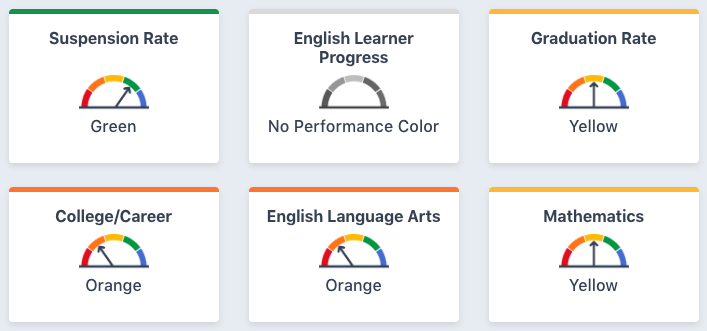What's on the Dashboard?

Performance
Part Two in a series
California's way of measuring the success of schools and districts changed dramatically with the unveiling of the California School California School Dashboard in March of 2017. Rather than relying on test scores alone, the Dashboard assembles a variety of "indicators" to help parents and communities understand how well schools and school districts are doing. The Dashboard combines data collected by the state ("state indicators") with additional information collected by school districts. This post, #2 in our series, focuses on the information that the state compiles for the Dashboard to measure "performance".
Colorful Gauges Show Performance
The Dashboard uses icons that look like gauges to represent school and district performance.
Each gauge (and its associated color) represents a performance level, meant to indicate good performance as well as conditions that warrant attention. Performance is more than a snapshot of the latest results. It evaluates results in comparison to past performance, combining assessment of current conditions ("status") with measurement of progress ("change"). Are things looking up? Is there a downward trend?
The distribution of performance levels varies by indicator and can vary over time. Generally, you will see red and blue the least. Orange, yellow and green are more common, with yellow generally the most common.

Performance levels are not defined by a fixed grading curve, but by "threshold levels" (cut points) set by the State Board of Education. (See Part 3 in this blog series: How the Dashboard Gets Its Colors.
What are the Indicators?
The indicators on the dashboard summarize performance in several categories, most but not all of them academic. New indicators were introduced in the 2018-19 school year, and some indicators remain under development (as indicated below).
Academic Performance |
|---|
|
> English Language Arts. (Grade 3-8 and grade 11 CAASPP language arts scores) > Mathematics (Grade 3-8 and grade 11 CAASPP math scores) > English Learner Progress (Student scores on ELPAC) > College/Career Readiness (The percent of students per year that qualify as Not Prepared, Approaching Prepared, and Prepared based on multiple measures) > Science (12th grade CAST scores) — under development > Computer Science — under development > Implementation of Academic Standards (Pass/Fail). Each school district awards itself a met/not met rating as a "local" indicator on the dashboard. The ratings are predictably useless, but the text submitted to justify the rating can be illuminating. |
Academic Engagement |
|
> Chronic Absenteeism (Grades K-8). Although attendance is the real goal, the dashboard tracks the inverse: absenteeism. This indicator reflects the rate of chronic absenteeism, defined as missing at least 10% of instructional days. (Detailed absentee data available from the Department of Education is reflected in the Dashboard.) The first step in addressing absenteeism is to recognize patterns, which the Dashboard makes possible. > Graduation Rate (Four-year cohort rate). Generally, this measures the percentage of students entering as ninth grade students who graduate in four years or fewer. Some exceptions were clarified in 2018. > Access to a Broad Course of Study (Pass/Fail). Each school district awards itself a met/not met rating as a "local" indicator on the dashboard. The ratings are useless, but the text can be helpful. |
Conditions and Climate |
|
> School Suspension Rates. This indicator reflects the percentage of students (in any grade) that have been suspended one or more times in the current school year. The target rates vary by grade level. > Access to the Basics: Teachers, Instructional Materials. (Pass/Fail) Each school district or charter school rates is asked to rate itself on a pass-fail basis. The ratings are pretty useless, but the comments that districts include with their rating can be useful. > Parent Engagement (Pass/Fail) Another self-reported rating useful mostly for any comments. This is the place on the Dashboard where districts could choose to include information about participation in Ed100. > Local Climate Survey (Pass/Fail) Another self-reported rating. |
How do the Dashboard colors work in practice?
Most of the time, you will see data from the Dashboard in the form of reports about your school or district.
Visit https://www.caschooldashboard.org/ and search for a school you know by name. You'll be presented with an interactive report that begins with something like this:

Click around. You aren't going to break it. You'll find that the Dashboard can take you to a certain level of depth, which we will explore. For example, you can view summaries of the performance of different student groups for different indicators, like this:

If you are looking for information about a specific school, at a certain point you will probably also find that you want to go deeper. Links to some of the answers are hidden in the Dashboard itself. For example, look for the purple buttons pictured below:

Other answers are further tucked away under links with labels like "pivot". For some answers, though, you'll be better off spelunking the data tools on EdSource, which can give you insights about student performance at specific grade levels in a specific school or district.
But before we get too far afield, it helps to clear up how the Dashboard actually determines these performance colors. The next post in this series will peek under the hood to explain how the Dashboard combines status and change to evaluate performance.
Updated June 2018, December 2018.
Mary Perry and Carol Kocivar contributed to this post.
Context: Ed100 Lesson 9.7
Part 1: Overview
Part 2: The Indicators
Part 3: Performance Colors
Part 4: Math and English
Part 5: English Learners
Part 6: Attendance and Absenteeism
Part 7: Suspensions
Part 8: Graduation
Part 9: College and Career Success
Part 10: "Local" Indicators for School Districts
Tags on this post
DashboardAll Tags
A-G requirements Absences Accountability Accreditation Achievement gap Administrators After school Algebra API Arts Assessment At-risk students Attendance Beacon links Bilingual education Bonds Brain Brown Act Budgets Bullying Burbank Business Career Carol Dweck Categorical funds Catholic schools Certification CHAMP Change Character Education Chart Charter schools Civics Class size CMOs Collective bargaining College Common core Community schools Contest Continuous Improvement Cost of education Counselors Creativity Crossword CSBA CTA Dashboard Data Dialogue District boundaries Districts Diversity Drawing DREAM Act Dyslexia EACH Early childhood Economic growth EdPrezi EdSource EdTech Education foundations Effort Election English learners Equity ESSA Ethnic studies Ethnic studies Evaluation rubric Expanded Learning Facilities Fake News Federal Federal policy Funding Gifted Graduation rates Grit Health Help Wanted History Home schools Homeless students Homework Hours of opportunity Humanities Independence Day Indignation Infrastructure Initiatives International Jargon Khan Academy Kindergarten LCAP LCFF Leaderboard Leadership Learning Litigation Lobbyists Local control Local funding Local governance Lottery Magnet schools Map Math Media Mental Health Mindfulness Mindset Myth Myths NAEP National comparisons NCLB Nutrition Pandemic Parcel taxes Parent Engagement Parent Leader Guide Parents peanut butter Pedagogy Pensions personalized Philanthropy PISA Planning Policy Politics population Poverty Preschool Prezi Private schools Prize Project-based learning Prop 13 Prop 98 Property taxes PTA Purpose of education puzzle Quality Race Rating Schools Reading Recruiting teachers Reform Religious education Religious schools Research Retaining teachers Rigor School board School choice School Climate School Closures Science Serrano vs Priest Sex Ed Site Map Sleep Social-emotional learning Song Special ed Spending SPSA Standards Strike STRS Student motivation Student voice Success Suicide Summer Superintendent Suspensions Talent Teacher pay Teacher shortage Teachers Technology Technology in education Template Test scores Tests Time in school Time on task Trump Undocumented Unions Universal education Vaccination Values Vaping Video Volunteering Volunteers Vote Vouchers Winners Year in ReviewSharing is caring!
Password Reset
Search all lesson and blog content here.
Login with Email
We will send your Login Link to your email
address. Click on the link and you will be
logged into Ed100. No more passwords to
remember!














Questions & Comments
To comment or reply, please sign in .